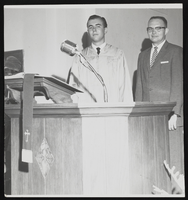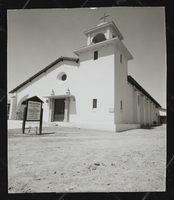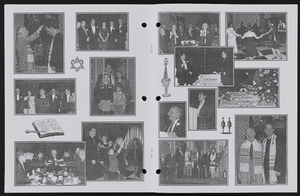Search the Special Collections and Archives Portal
Search Results

Photograph of youth worship leaders at church podium, (Nev.), 1940-1960
Date
Archival Collection
Description
Image
Max Goot oral history interview
Identifier
Abstract
Oral history interview with Max Goot conducted by Charles Collins on March 22, 1976 for the Ralph Roske Oral History Project on Early Las Vegas. Goot recalls the growth of Las Vegas, Nevada after 1945. He also talks about winning the Man of the Year Award from his temple.
Archival Collection

Mauricia Baca interview, December 16, 2019: transcript
Date
Archival Collection
Description
Interviewed by Elsa Lopez and Claytee White. Mauricia Baca, Director of Get Outdoors Nevada, was born to a Jewish American mother and Mexican father who settled in New York City. She overcame the economic obstacles of her early life to graduate from Vassar College and University of New York Law School, where she learned to be proud of her identity. Subjects: Jewish, Education, Law School, Latinx, Mexican
Text

Photographs from the Holocaust Education Seder event at the Rio Hotel, April 6, 2014
Date
Archival Collection
Description
An essay by Esther Toporek Finder accompanying the photographs describes the event: "Holocaust survivors, along with Clark County students and teachers, sat down to break matzo and bread together at Las Vegas? first Holocaust Education Seder Sunday (April 6) at the Rio Hotel. Three generations from the survivor community gathered with middle and high school students and teachers from elementary, middle, and high schools. The leader for the traditional portion of the service was Rabbi Sanford Akselrad and the Shoah segments were led by Professor Esther Finder. Kevin Janison, from MyNews3, served as host and MC. Both Finder and Janison are children of Holocaust survivors. Ray Fiol lit candles on behalf of the approximately six million Jewish victims of the Holocaust and a 7th candle to represent the non-Jewish victims of Nazi atrocity. Music was provided by Cantorial Soloist Lola Rivera. Educator and librarian Susan Dubin shared original poetry as part of the blessing after the meal. Participants dined on foods traditional for Passover: matzo ball soup, roasted chicken with matzo kugel, tsimmis and a non-dairy chocolate dessert."
Image

Photograph of Christ Church Episcopal, Las Vegas (Nev.), circa 1910
Date
Archival Collection
Description
Image

Transcript of interview with Rabbi Mendy Harlig by Barbara Tabach, October 18, 2017
Date
Archival Collection
Description
Known throughout the Las Vegas community as Rabbi Mendy, Mendy Harlig is a leader of the Chabad in Las Vegas, which was introduced to the valley in 1990 by his brother Rabbi Shea Harlig. Since his youth spent growing up in the Crown Heights section of Brooklyn, where he was surrounded by Hasidic Jews, Rabbi Mendy seemed destined to become a Chabad rabbi. During the early 1990s he often visited Las Vegas and assisted his brother at the Chabad of Southern Nevada. Then in 1997 he met and married Chaya Harlig and the couple permanently relocated to the valley to be the spiritual leaders of the Chabad of Green Valley. As their family grew, so did their importance to the Chabad movement in Las Vegas. During this interview, Rabbi Mendy touches upon the nature of Chabad teachings and observance in the so-called “Sin City” persona of Las Vegas. He also shares about his participation in the Las Vegas Metro Chaplaincy program. He particularly reflective of his active role immediately after of the horror of the October 1 mass casualty at the Route 91 country music festival and his perspectives afterwards.
Text
Stewart, Omer Call, 1908-1991
Omer C. Stewart (1908-1991) was Professor Emeritus of the Department of Anthropology at the University of Colorado in Boulder, Colorado and a renowned scholar of indigenous religions, particularly peyotism. He was also an outspoken advocate for the indigenous nations of the United States. Omer C. Stewart and Martha C. Knack wrote a book together in 1984 titled As Long as the River Shall Run: An Ethnohistory of Pyramid Lake Indian Reservation.
Source:
Person



